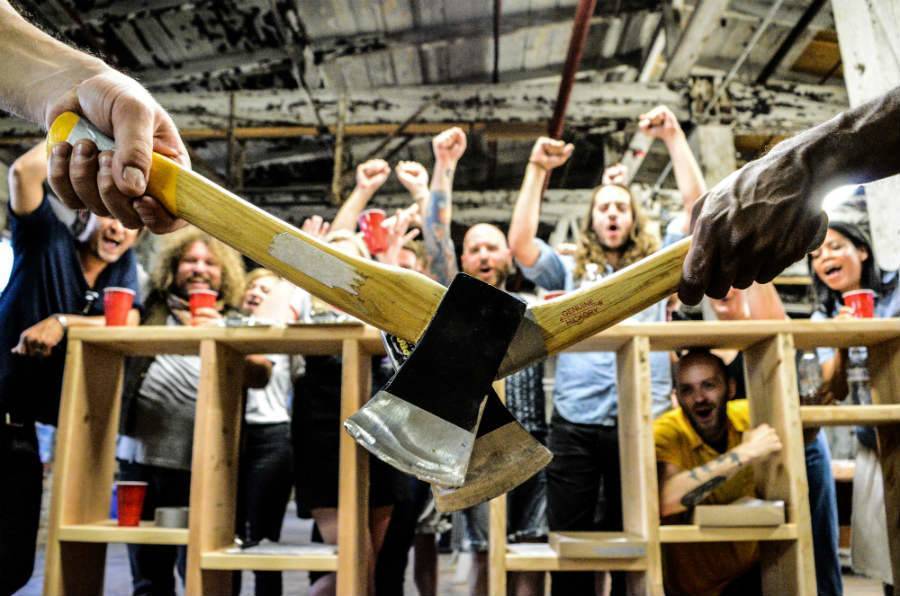CHAPTER 1
Let me axe you a question: how many online bookings does your axe throwing business receive? Whether your answer is low or high, it’s possible for this number to increase. Axe throwers are eager to book online — you just have to tailor the online booking experience to go along with consumer behaviour.
Located in Philadelphia, USA, Urban Axes was established in 2016 to bring the joy of axe throwing to an urban environment. In two short years, they’ve expanded to multiple locations on the east coast as they continue to grow. And it’s because they’re chopping down the competition by using Checkfront to create an easy booking flow for their customers.
Urban Axes receives 90% of their sales through online bookings versus the 10% taken by staff from walk-ins and phone calls. It’s evident their online strategy is paying off. With online bookings being their champion in sales, they have lower staff overhead — which allows Urban Axes to maximize profitability.
“Checkfront takes the pain out of managing our customer bookings, and allows us to focus on delivering our customer experience instead.”
Shaun Hurley, Co-owner & IT Director
Let’s take a look at how Urban Axes utilizes Checkfront to reach this high conversion rate.
Base booking on number of players
Axe throwing is a perfect activity for large groups — whether it’s a family function, a team-building event, or a group of friends competing to see who’ll make the best lumberjack.
When someone plans an axe-throwing event, they’ll gather up a group of competitors by scheduling a day that works best for everyone. Before they book, they know the number of people who’ve said yes and the date and time they want to go. So that’s the only information they care about.
On the business end, Urban Axes requires more; they also need to know how many lanes to reserve per booking. Here are the possible scenarios:
- Have the customer choose the number of lanes when booking
- Have their staff manually assign the number of lanes after a new booking comes through
- Have Checkfront automatically assign the number of lanes on the back-end when a booking is being made
If Urban Axes hands over the number of lanes requirement to the customer, they’ll immediately have a question — what is the maximum number of players per lane?
Even if Urban Axes explains in the booking details, the customer will spend time figuring it out and may contact them for help. And this extra effort might be a reason the customer abandons the booking altogether.
As for option 2, Urban Axes doesn’t want to create more work for their team — so that leaves the last possibility.
For Urban Axes, offerings are based on the number of players and inventory refers to the number of lanes. By setting this up as an attribute on the back-end, Checkfront can control two variables at once — reserve the right number of lanes and set limits on player amounts.
Less than 4 booking options
Giving too many choices can hurt conversion rates. Have you ever been online shopping and were overwhelmed by the vast amount of options? Were you able to decide on the best one and follow through with a purchase?
It’s understandable when a business believes the more options offered, the better — there’s something desirable for every type of customer. But this doesn’t optimize the user experience. In fact, choice overload generally causes the customer to feel discomfort, which leads to cart abandonment.
Urban Axes only ever displays 2 booking options on their website. Since bookings are based on the number of players, instead of having a booking option for each, they limit the choices by using a quantity range.
For example, here are the choices a customer can make:
On weekdays
- 6-12 players
- 13-24 players
On weekends
- 8-12 players
- 13-24 players
These choices cover all group sizes still — except for 5 or less, which is encouraged as a walk-in — but the customer doesn’t have to select from a long list.
Only 3 required form fields
Similar to booking options, less is more when it comes to form fields. For most customers, taking the time to fill out a form is a painful experience — especially if it’s done on a mobile device. It’s not only time consuming, but it’s easy to make an error.
However, Urban Axes needs a booking form to collect useful information about their customers. With contact information, like an email or a phone number, they can send out a reminder and thank you message for the booking, and a name helps to build a relationship with the customer.

As you can see, that’s only 3 booking form fields mark as required: Name, Email and Phone Number. It’s also ideal to ask for an Address, as this information benefits marketing, but Urban Axes keeps that optional.
There are more questions they can ask their customers — like age, experience level, flannel shirt size, beard length — but none of these fields are mandatory. With fewer form fields, customers take less time to type, which allows them to be quicker at hitting the checkout button.
Accept a 25% Deposit
Until now, everything described above outlines how Urban Axes strategically designs the booking flow to encourage customers to complete each step. But how do they retain the booking once it’s made?
Urban Axes requires a 25% deposit at the time of booking. Asking customers to pay a portion upfront doesn’t scare them away — it reduces the chance of cancellations and no-shows.
Taking a deposit not only improves customer accountability but also helps Urban Axes maintain a positive cash flow. And if a customer chooses to cancel without notifying ahead of time, Urban Axes can still cover their expenses.
If learning about Urban Axes has convinced you to take the next step, you’ll have to get your manager on board. In the next chapter, you’ll discover 3 reports that will entice management to buy into Checkfront.
Next Chapter: 3 Booking Reports for Axe Throwing Management
Home: The Complete Guide to Axe Throwing Software



